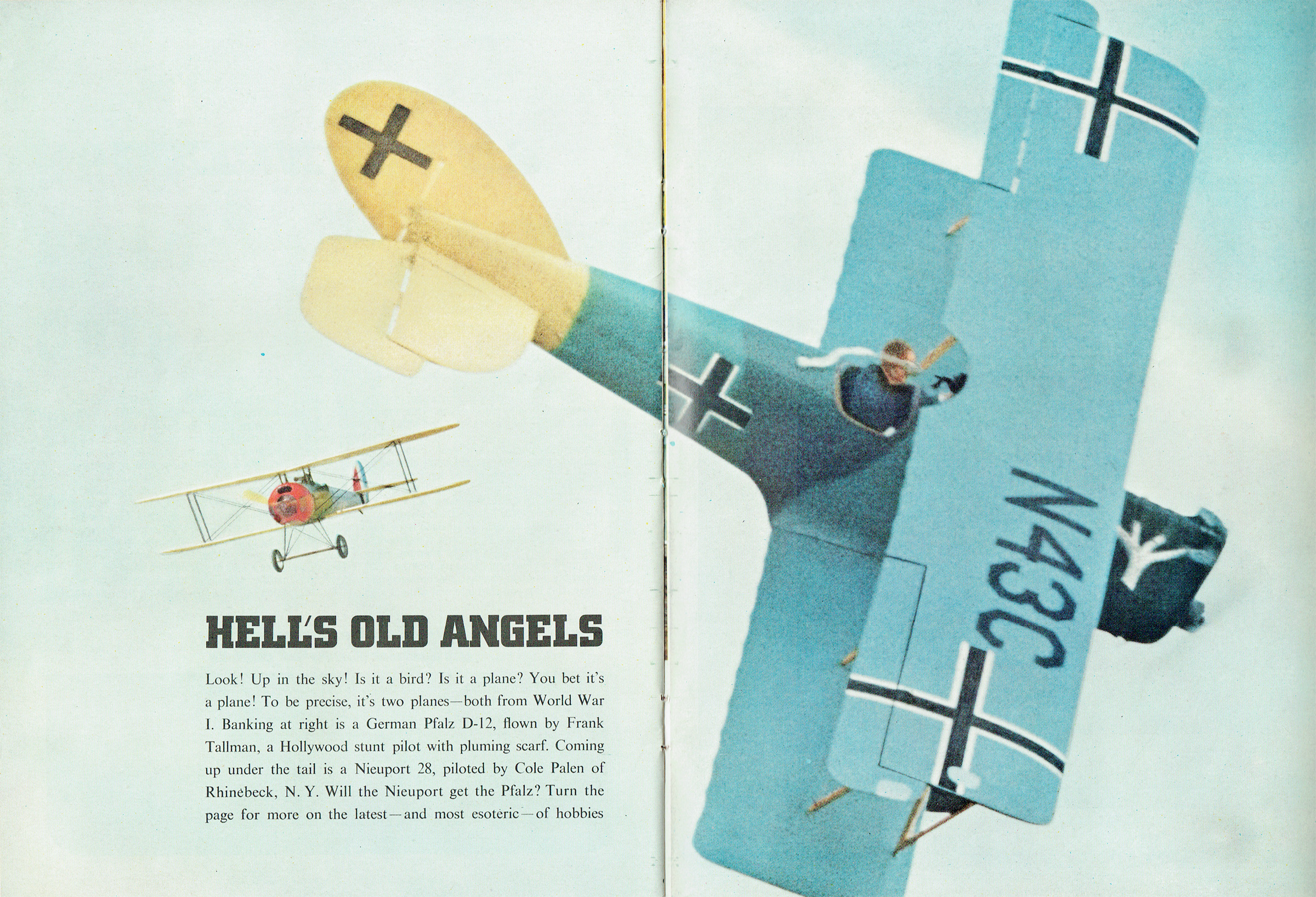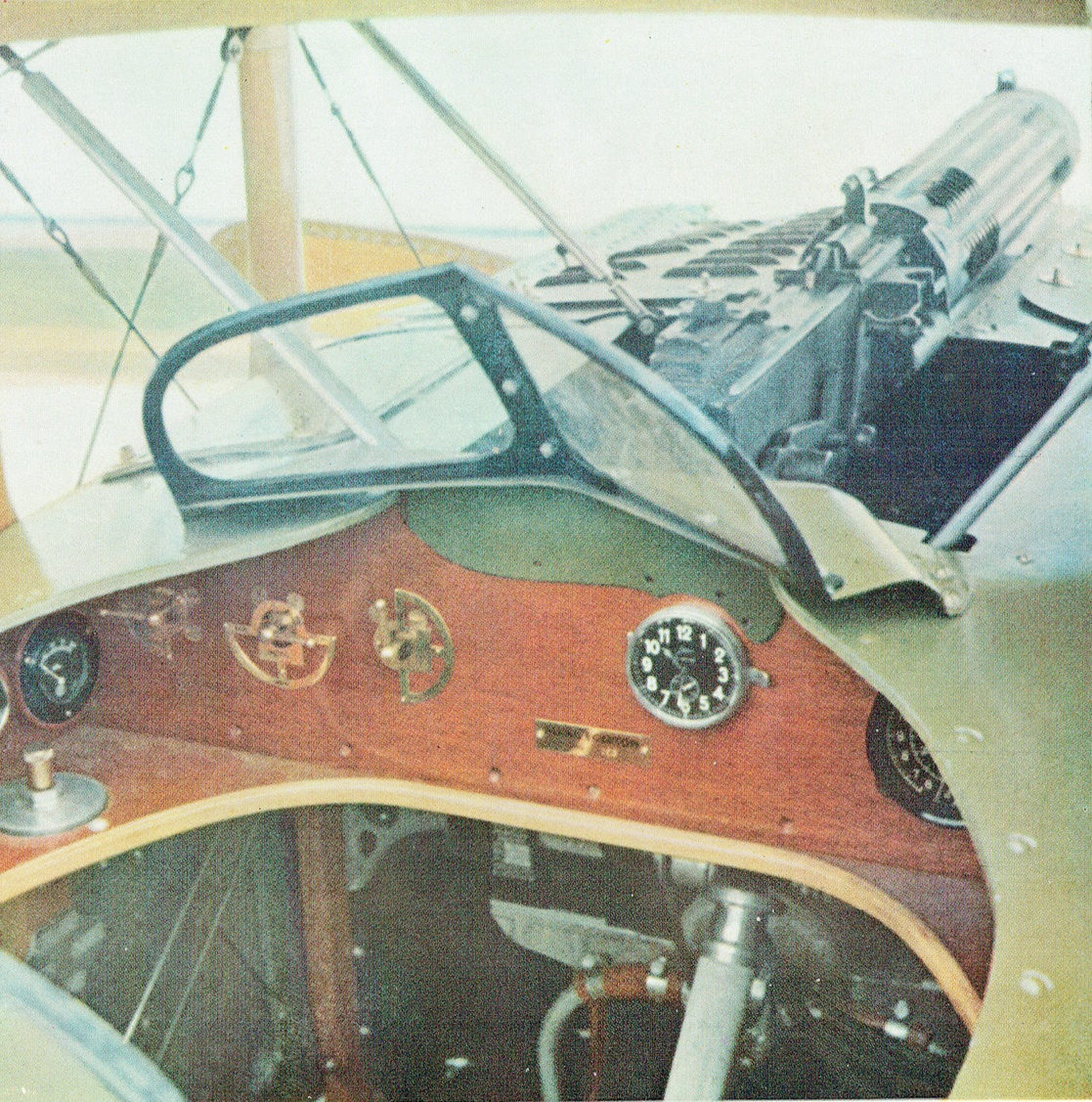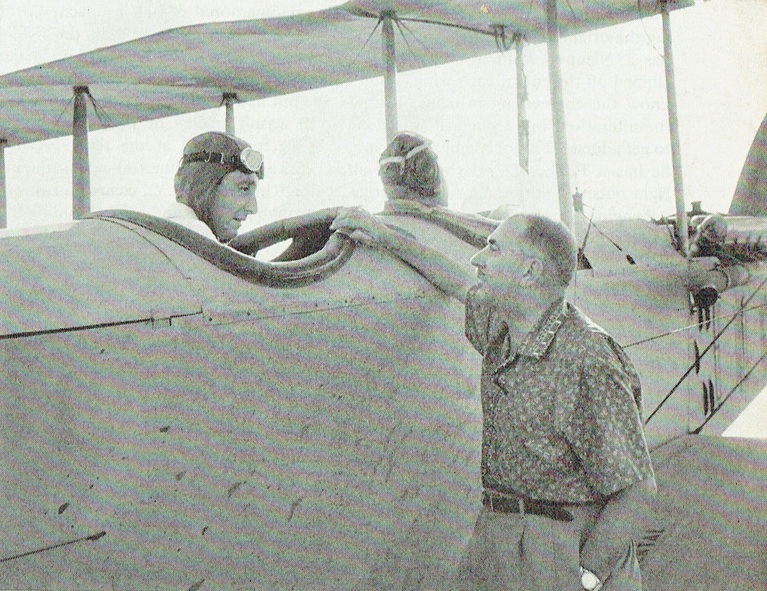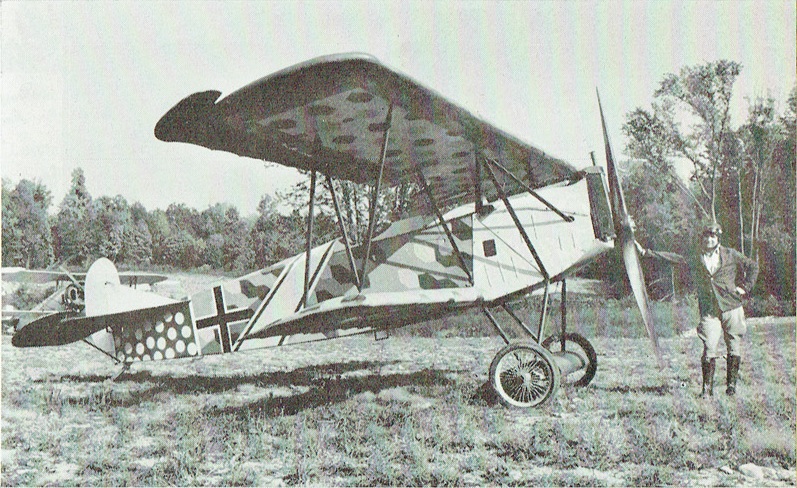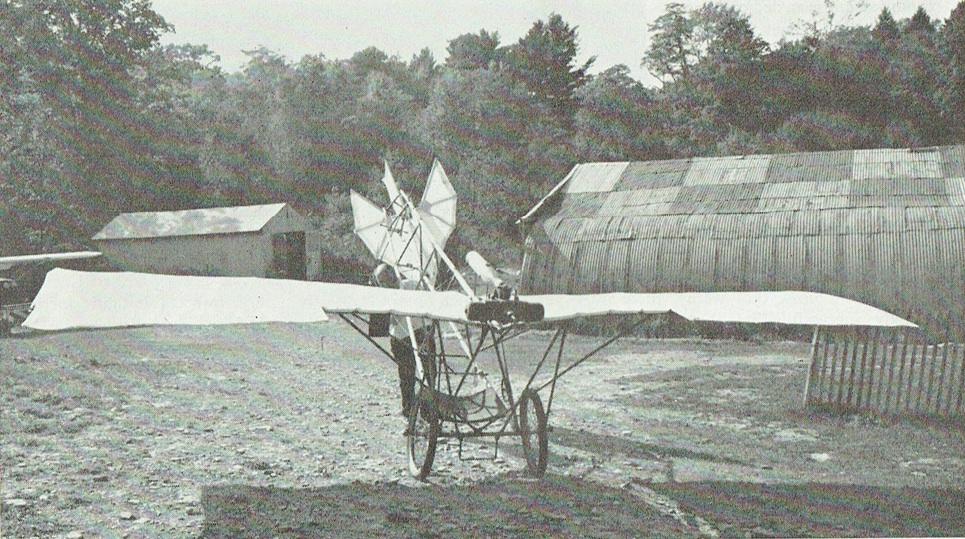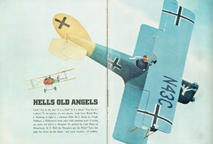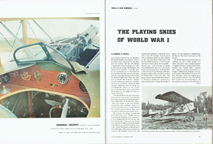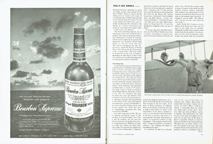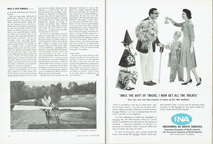Hell’s Old Angels
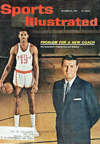 In October of 1961, Sports Illustrated ran an article on the emerging hobby of collecting Spads, Nieuports and other real live airplanes from World War I. The article centers mainly around collectors Paul Mantz and Cole Palen, but it does mention the interest surrounding The Great War that was growing at the time with interst being shown by book publishers and movie and television producers. With a mention towards America’s number one World War flying Ace—G-8!
In October of 1961, Sports Illustrated ran an article on the emerging hobby of collecting Spads, Nieuports and other real live airplanes from World War I. The article centers mainly around collectors Paul Mantz and Cole Palen, but it does mention the interest surrounding The Great War that was growing at the time with interst being shown by book publishers and movie and television producers. With a mention towards America’s number one World War flying Ace—G-8!
|
|
The Playing Skies of World War I
by Robert H. Boyle (Sports Illustrated, 30 October 1961 (vol.15 no.18))
Every age in history has its admirers. Raymond Duncan, the dancer, wears a homespun tunic and longs for the glory that was Greece. The late Sol Bloom, Congressman, loved nothing more than to dress up as George Washington, the Father of our Country. A goodly number of Americans are so bewitched by the Civil War that they recently refought, with no noticeable change in the result, the Battle of Bull Run. Now the latest craze is World War I planes. Antique aircraft enthusiasts, joined by a smattering of sports car drivers, classic car buff’s and gun collectors, most of whom are psychologically driven to the exotic, have, in the last three years, seized upon World War I as an outlet for their romantic fantasies.
“The World War I interest is just doubling itself by the month,” says Robert McGrath, proprietor of the World War I Aero Bookshop in Roslindale, Mass. “With the advent of jets and missiles, aircraft lost their romance. A jet or a missile is just the carrier of a pilot. World War I pilots flew the plane. They were charioteers, and it was man against man.”
|
|
Mel Tormé, the singer, a dedicated World War I fan, says, “People who are fascinated by flying are, if not disgusted, at least disillusioned by this jet age, this push-button age.” Two years ago Tormé and a number of other enthusiasts helped Hugh Wynne, an architect in Santa Ana, Calif., found The Society of World War I Aero Historians. The society now has upwards of 500 members in the U.S. and abroad and publishes a scholarly quarterly, Cross & Cockade Journal, given over to detailed articles on such subjects as the Austrian Berg single-seater and the Escadrille Lafayette. (”A lot of junk has been written about the Escadrille,” Wynne says, “and all kinds of people have claimed they were in it.”) In recognition of growing interest in World War I, the U.S. Air Force Museum at Wright-Patterson AFB in Dayton held a reunion for World War I flyers last June. The guests, led by Captain Eddie Rickcnbacker, America’s leading ace, looked on as pilots performed in vintage World War I planes. No one indulged in dogfighting, but the day that that returns may not be far off.
The World War I craze shows signs of catching on with a wider public. Li’l Abner, the comic strip, recently featured a dogfight between Captain Eddie Ricketyback and “Kaiser Bill’s Greatest Ace,” Baron Ludvig von Henhausen. A couple of Hollywood producers are racing to get their World War I series on TV first. (Actually, there may well be more than enough room for two. The World War I genre has, the Lord help us, all the exploitive potential of the Western.) Riverside Records, specialists in sports car engine sounds, have pressed World War I Fighter Planes in Action, the big selling point of which is the sound of two German Pfalz D-Xlls being pursued by two British Sopwith Camels. To add to the realism the sound track even includes machine-gun fire directed at the Bodies by a French infantryman, who opens up, according to the jacket notes, “a little soon to be effective.”
The book publishing business, too, is beginning to take note of World War I interest. The leader in the field is Harleyford Publications Limited of England. The firm has brought out several lavishly illustrated and expensive ($8.50 each) books, e.g., Air Aces of the 1914-1918 War and von Richthofen and The Flying Circus, which The Society of World War I Aero Historians has pronounced to be “a noble effort.” The main outlet for Harleyford in the U.S. is Gordon’s Bookshop on 59th Street in New York City, hitherto the unofficial headquarters for automobile cultists of all kinds.
The Flying Spy
Long-forgotten histories of World War I aeronautics are suddenly being sought after as classics, and prices have tripled in the past few years. A fine copy of Norman Hall’s Balloon Buster Frank Luke of Arizona brings $30. Hall and Nordhoff’s two-volume study, The Lafayette Flying Corps, sells for up to $ 150, and the war letters and memorial volumes, dedicated to such flyers as Edmond Genet, Norman Prince, Victor Chapman and Hamilton Coolidge fetch as much as $75 apiece. The latest writer to come on strong is Elliott White Springs. His books, written in the ’20s, are common, but since his death two years ago interest in his work has revived. (An eccentric mill owner, Springs is perhaps best remembered as the author of the saucy Springmaid advertisements. An ace in World War I, he wrote a handful of flying stories and novels, notably War Birds, that were so astonishingly successful that they earned him $250,000.)
Even pulp magazines of the ’20s are in demand, particularly copies of the monthly, G-8 and His Battle Aces. G-8, it may be recalled, was not only the Master American Flying Spy but a master of the makeup kit. Whenever G-8 got in a tight spot, which was about every other page, he removed his makeup kit “from its secret hiding place,” disguised himself and quickly outfoxed the hated Huns who were searching the woods for that “verdammter Kerl!” Little did they know that the old farmer bicycling down the road was the Master Spy making his getaway. Assisting G-8 were his Battle Aces, big Bull Martin, “former All-American halfback,” and Nippy Weston, “the little terrier ace who defied superstition by flying Spad No.13 and who delighted in laughing in the very face of death.”
Of course, the most desirable possession any World War I hobbyist can have is a plane. According to a recent count taken by Professor Dean H. Obrecht and Leonard E. Opdycke of Rochester, N. Y., there are 70 authentically restored World War I planes in the U.S. today, 35 of them in flying condition. In addition, there are 44 replicas, which do not rank as high in the scheme of values as do restorations. If the plane is almost exactly as it was the day it left the factory or the day it arrived at the front, it is incomparably desirable. Restoration or replica, it is important to have an original engine. “The airplane can always be built,” explains Cole Palen, a prominent collector, “but building the engine is something else again.”
It is perfectly all right for a licensed pilot to fly a World War I plane today as long, of course, as the plane can pass Federal Aviation Agency inspection. (One collector was irked when an FAA inspector grounded his Spad because of rents in the original linen wing skin. “I thought it was all right,” the collector said, “but he was new, and I guess he was afraid.”)
Aloft, World War I planes are prohibited from flying over cities and villages or any open area of assembly. Though this would tend to indicate some doubt about the durability of the planes, pilots say that with the necessary maintenance the planes hold up reasonably well. In fact, many of the planes can outclimb and outdive light planes of comparable size today. A Spad, for instance, can climb 1,000 to 1,200 feet a minute, a respectable figure for almost any single-engine private plane. However, there are some problems, mainly in landing. The landing gear was built for grass, and a pilot who alights on concrete may as well write off the plane. A Spad is especially difficult to land because of its built-in urge to ground-loop. The Spad has too much weight in the tail, 333 pounds to be exact, and when it touches down in the classic three-point position, it shows a compulsive urge to go down the field backward instead of forward.
|
|
There are three major collections of World War I planes in the U.S. The largest, 45 planes in all, belongs to Paul Mantz, three-time Bendix trophy winner and stuntman (he was the first in Hollywood to fly through an open hangar), who keeps the fleet on hand for the movies. (Counting all types of aircraft, Mantz once owned 600 planes, ranking just ahead of Nationalist China as an air power.) Alas, some purists look down upon Mantz’s collection. “He cuts up his planes a lot,” says Hugh Wynne, “and doesn’t worry much about preserving the original design. For example, he has a Nieuport with a couple of feet clipped off the end of each wing. I don’t know the engineering principle behind the alteration, but I guess it was done to get added speed for racing. Then, too, he has a Fokker D-VII that looks all right outside but doesn’t have the original engine. We aren’t lotus eaters on this subject, you understand, but we just feel that Mantz’s collection is not outstanding from a historical standpoint.”
Wynne has more respect for the collection of Frank Tallman, also a stunt pilot. Tallman, 42, whose father flew for the Navy in France, has been collecting World War I planes for 15 years, and he now has six of them. The prize of the collection is a Pfalz D-XII (the one Riverside used in its recording). Unfortunately, he wrecked it at Wright-Patterson in June after the engine stalled at 400 feet. He ground-looped on landing and smashed the lower right wing and landing gear. Tallman was unhurt. A dashing, mustachioed chap, Tallman revels in wearing riding boots, breeches and a white silk scarf. “When he gets dressed up,” an acquaintance remarks, “he looks like G-8 for sure.”
|
|
In the East the outstanding collection belongs to Cole Palen, 35, an aviation mechanic. While learning his trade at Roosevelt Field, Long Island, Palen became enamored of half a dozen World War I planes on exhibit in the field’s museum. When the field had to make way for, of all things, a shopping center, he put in a successful bid for the planes. “It wasn’t much,” he says, “but it was every cent I had at the time.” A few years ago he bought a 100-acre farm outside Rhinebeck, N.Y., cleared a runway through pastures and began building the Old Rhincbeck Aerodrome, a replica of a World War I base in France. To raise money for its construction he has flown his planes at air shows all over the country, and he recently picked up a substantial sum exhibiting his Blêriot XI for a Wings brassiere advertisement.
Though much work remains, the Old Rhinebeck Aerodrome is open to the public for a modest admission charge. Palen has landscaped the grounds so that visiting cars are hidden behind an embankment, the only cars out in the open being a 1917 Maxwell truck and a 1910 Sears auto buggy. “I want to preserve the spirit of a World War I aerodrome,” he says. The corrugated hangar is decorated with World War I posters admonishing the viewer to halt the Hun by buying Liberty bonds. Visitors are free to inspect the planes. The most colorful is a Fokker D-VII rendered in a mottled camouflage pattern with a red-and-white polka dot squadron designation on the tail. Palen, decked out in riding trousers, scarf, helmet and goggles, acts as guide. As an added touch, a white handkerchief trails from the top of his helmet. “That’s to wipe the oil off the goggles,” he explains.
A lot of color
The tour over, some visitors are permitted to clamber into the cockpit of a Nieuport 28 and try out the controls. The plane is tied down, but there is a great sense of exhilaration as Palen starts the engine. There is even more if the engine happens to catch fire, which it is prone to do. “That adds a lot of color,” says Palen, eyes aglitter. “In fact, it’s got to the point where we might get it on fire on purpose.”
|
|





